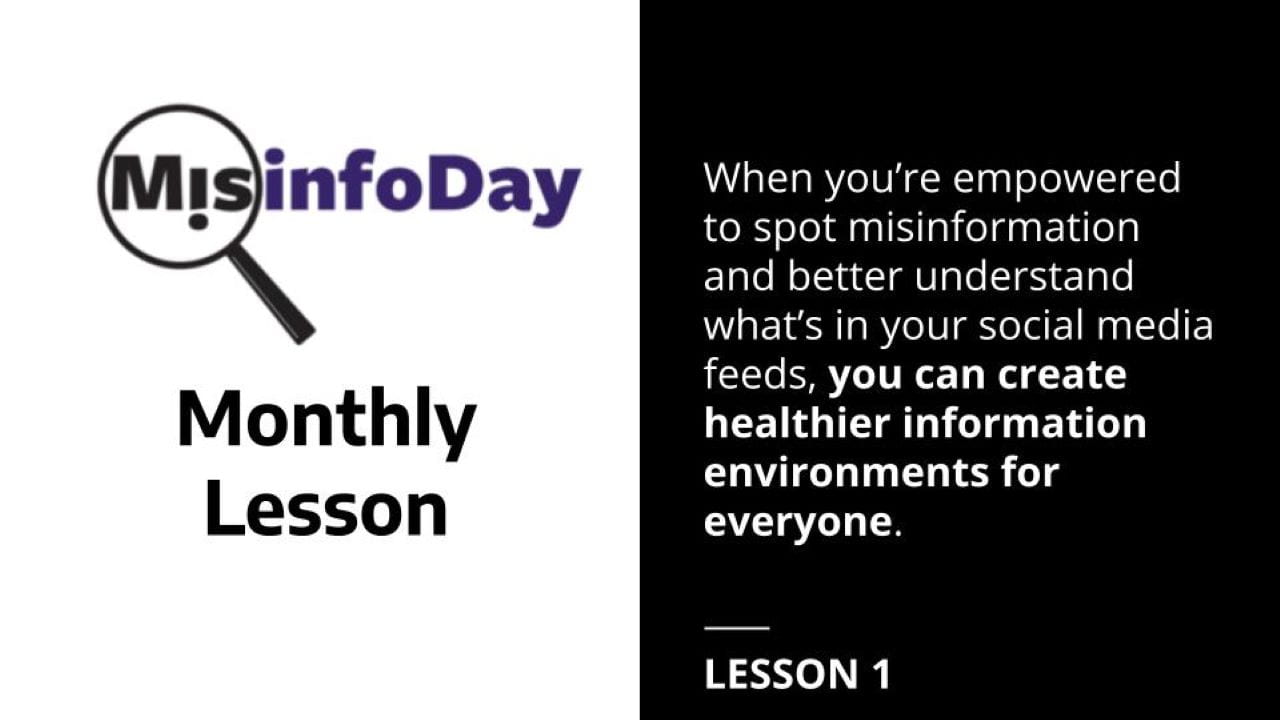Leading up to MisinfoDay 2022, the UW Center for an Informed Public, in partnership with the WSU Edward R. Murrow College of Communication, has launched a series of MisinfoDay Monthly video lessons for secondary students and educators leading up to next year’s event.
In our September MisinfoDay Monthly video, Mia Saunders, a senior at Ballard High School in Seattle, talks with Jevin West, an associate professor in the UW Information School and cofounder of the Center for an Informed Public, about how we can be empowered to spot mis- and disinformation and help create healthier information environments for everyone.
Mia and Jevin discuss the difference between mis- and disinformation, what unexpected forms misinformation can take, how memes can spread misinformation, and top tips for creating healthy information environments.
1:42 | What is the difference between mis- and disinformation?
4:18 | What are some less obvious forms that mis- and disinformation might take?
6:40 | Memes and mis- and disinformation
9:26 | Top takeaway tips to create a healthier information environment
13:26 | Closing
Scroll down to watch the video and access resources for topics discussed in this video.
Sign up to receive future MisinfoDay Monthly lessons and other updates here. Each lesson will feature a video conversation between a high school student and a misinformation researcher along with related resources for your classrooms.
Related Resources for Educators: September 2021 Video Lesson
Uncovering Reality Virtual Exhibit (slideshow)
Examine six charts to learn some of the common ways data visualizations can be accidentally distorted or intentionally manipulated. Can you spot what’s wrong with the chart?
Created by Pacific Science Center with the University of Washington’s Center for an Informed Public
AI-enabled learning algorithms are now able to easily generate synthetic “photographs” of people. Your task: guess which one is real.
Created by the University of Washington’s Calling Bull project
As Jevin said in the video above, investigating the source of online information is one of the best things you can do to create healthier information environments for everyone. Learn how to do this through three short videos and three practice examples.
Created by Canadian nonprofit CIVIX with WSU digital literacy expert Mike Caulfield and BuzzFeed News Disinformation Reporter Jane Lytvynekno
How to Use MisinfoDay Monthly Materials
Have your own “monthly MisinfoDay.” Choose a day each month to let students explore some or all the resources. There are lots of ways to mix and match. One option for this month: start class with an example from the Which Face Is Real? game or Uncovering Reality exhibit, then watch Mia & Jevin’s conversation for context on the mis- and disinformation landscape. End with the Investigate the Source videos and practice so students feel empowered to discern trustworthy from untrustworthy sources.
Find the Facts Fridays. Choose a day each week to explore one of the four resources at the start of class. Short on time? Choose one resource to focus on for the month and break it down into shorter warm-up activities. For example: Each Friday in September, watch one question from Mia and Jevin’s interview, or look at one graph from Uncovering Reality, or practice one example from Investigate the Source.
Get inspired. Review the materials to level up your own understanding of the misinformation landscape and how to navigate it, then use your new knowledge to incorporate these concepts and skills into your current curriculum.
- Sign up to receive our monthly lessons and MisinfoDay 2022 planning updates.
- Do you work at a college or university that may be interested in hosting a local MisinfoDay event? Check out our online guide: “How to Host Your Own MisinfoDay: A Guide for Colleges and Universities“




